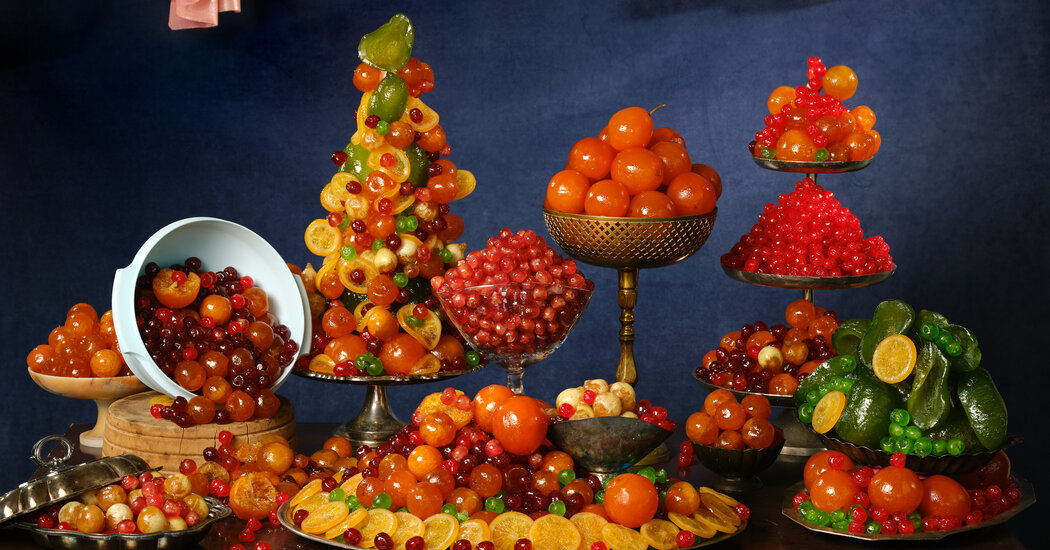
INSIDE A GILDED Rococo room on the Avenue Montaigne in Paris, candied fruits dangled from winterberry tree branches. Hand-sewn to the limbs with waxed twine by the food artist Imogen Kwok and her team, the sugar-confit-dipped pears, clementines and cherries resembled orbs of glass and were clipped off by guests with bonsai scissors for an interactive dessert course.
That event was for the fashion house Loewe, but candied fruits are a signature for the Sydney-born, London-based Kwok, who trained in the Michelin-starred New York kitchens of Eleven Madison Park and Blue Hill at Stone Barns. The 32-year-old incorporates them frequently in her work: She has arranged candied kumquats in the pattern of fish scales atop salmon fillets for an afternoon tea hosted by Prada and filled 17th-century vessels with heaps of candied clementines and yellow cherries for a Sotheby’s fete. “I positioned a spotlight over the cherries to make them really light up; it was like looking at a jewel,” says Kwok, who holds a master’s degree in art history from the University of St. Andrews in Scotland and was inspired by the Dutch golden age painter Adriaen Coorte’s hyperrealistic renderings of produce. “Candied fruit is so luminous; it has this ethereal quality when the light hits it.”
Kwok isn’t the only one bewitched by the properties of candied fruit these days. “Just like in fashion or design, in food there are aesthetic trends, and they’re always a reaction to what’s come before,” says the New York artist Laila Gohar, 35, who served glistening candied peaches, plums, clementines and green shishito peppers on simple white plates at an Hermès party in Milan in April. “The mid-2000s was very rustic. But now we’re inspired by something that might be found in the court of Marie Antoinette.” Growing up in Cairo, Gohar watched her father candy oranges and grapefruits in the kitchen. The process involves preserving a fruit by replacing its water content with sugar and is laborious and time-consuming. One first cores the fruit if necessary, briefly blanches it to soften the membrane of the skin and then repeatedly heats, cools and reheats it in an increasingly sugary syrup each day for weeks until it appears semitranslucent, while retaining its flavor.
“From Persia to France, everyone has their version and tradition,” says Gohar and, indeed, candied fruit goes by many names across cultures, from glacé fruit to sweetmeats to fruits confits. The practice dates back to the ancient Romans, who preserved the summer’s bounty of dates, pears and grapes for the winter in jars of honey. In 16th-century Elizabethan England, conspicuous displays of sugar, a pricey commodity at the time, became the ultimate boast, and banquet tables gleamed with candied fruits. “That was really one of the first ways people consumed sugar,” says Camilla Wynne, 42, the preserving expert and author of the book “Nature’s Candy” (to be published in 2024), about the history and methods of preserving fruit. Sucket, as candied fruit was called in the Tudor era — the name is derived from the French succade and the Italian succata — was consumed with special silver forks, she says: “They had two prongs on one end to spear the flesh and a spoon on the other to ladle the syrup.”
REFRIGERATION AND THE global produce trade may have obviated the need to preserve fresh fruit, but the British baker Stroma Sinclair, 33, the former head pastry chef at Skye Gyngell’s Spring in London, and the current cake maker at Leila’s Shop in the city’s Shoreditch neighborhood, says the process makes her more mindful about appreciating Europe’s growing seasons and the rhythms of nature. She preserves Pursha limes, pomelo, Tarocco blood oranges and kumquats each winter and uses them to adorn her confections throughout the year.
The London caterer and creator Marie Cassis, 25, of the popular @aromecassis Instagram account, which features evocative images of her Old World recipes, returns each spring to her family’s farm in northeast Cairo to candy their small, thin-skinned clementines. “It’s a very long and difficult process but, at the end, you have this beautiful object that looks like stained glass,” she says. Her annual pilgrimage is a tribute to her Greek grandmother, who makes clementine and apricot glyko tou koutaliou, or “spoon sweets,” a homemade Greek dish of fruit — typically sour cherries or citrus — preserved in syrup and served in a spoon on a small crystal plate with coffee. Cassis recalls her opening jars of perfectly shiny globes of citrus that had been candied the spring before in the middle of winter, when fresh fruit was scarce. “She always talks about honoring the fruit and the beauty of keeping it whole,” Cassis says. “That’s what I find so special about the process — the result is something that’s completely transformed yet has also kept its original shape. You work so hard to achieve it, but it makes you feel good.”
Set design by Jocelyn Cabral. Photo assistant: Omer Kapski. Set designer’s assistants: Maggie DiMarco, Adrian Ababovic. Fruit: courtesy of frankandsal.com, ifigourmet.com, sahadis.com



